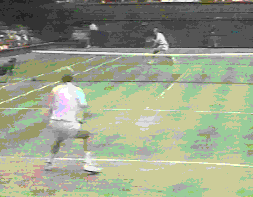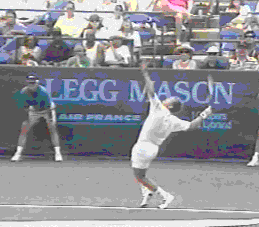|
TennisOne Lessons
The Gravity Step
The
identifying movement is the quarter hip turn and simultaneous stepping
back or beneath the moving body. It's as Simple
as Falling Down
To
understand the dynamics of balance and loss of balance try the following
practical experiment. In the ready position your base of support (BS) is
with feet spread shoulder width, and the center of gravity (CG) resting
comfortably above the BS. Stand alongside a wall, shoulders aligned at a
right angle to the wall, so that you can barely reach the wall with the
outstretched fingers of either the right or left hand. Now, lift the foot
closest to the wall off the ground. If you have not fallen against the
wall it was because you shifted your weight to keep from falling. This is
lateral motion, in that you fell laterally against the wall. To feel
forward motion, repeat the above exercise with a simultaneous Gravity turn
(hip turn) toward the wall. When done correctly you will catch your weight
with both hands as your chest turns to face the wall.
Practice this on the court with your coach or partner in the following way. The mover stands on the baseline, in the ready position, with the baseline center mark exactly between their feet. The coach faces the mover, standing 15 feet away. The coach claps hands and quickly points left or right. The mover practices reacting to the forehand or backhand side depending on where the coach points. The clap resembles the ball contact, and the pointing to one side or the other immediately after the clap approximates the players perception to the direction of the ball. The coach looks for both a drop step placed on top of the baseline center mark, and a simultaneous 90 degree unit turn toward the direction of movement. Who Uses It?
Players
renown for effortless movement: Stefan Edberg, Andre Agassi, Arancha
Sanchez, Monica Seles, Fabrice Santoro, Cedric Pioline, John McEnroe, Gene
Mayer and only a few selected others. Arancha
Sanchez uses this technique to reach outside balls along the baseline,
Stefan Edberg uses gravity motion at the net, and Monica Seles uses
gravity motion both to reach outside balls, as well as on her initial
recovery step back to the center of the court. Tennis is a game of movement, and the most important step is the first movement to the ball. The modern game is played with more power and is much faster than even a years ago. The comparison of the US Open highlights of 1974 with those of 1999 are interesting. The 1974 game seems like slow motion when compared with today's players. Now, more than ever, there is a real premium placed on movement and Gravity Motion consistently produces quick, efficient, and effortless movement to each and every outside ball. You and I might not play with the speed and power of Agassi or Seles, but we still have many situations where we need to really hustle. What works for the quickest professionals will work for you as well. This is the first in a series of articles on footwork. The material is derived from a new video by Jim McLennan, “The Secrets of World Class Footwork - Featuring Stefan Edberg”. The gravity turn is presently the subject of a research project at the
Stanford University Biomechanical Engineering laboratory. The results will
be published (in abridged form) on TennisONE.
|
Last Updated 9/1/98. To contact us, please email to: webmaster@tennisone.com TennisONE is a registered trademark of TennisONE and SportsWeb ONE; Copyright 1995. All rights reserved. |
|||||


